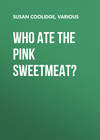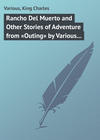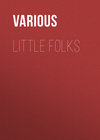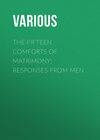Читать книгу: «Birds and Nature Vol. 11 No. 5 [May 1902]», страница 3
“You distract, humiliate me,” he hissed. “Your heart is no larger than your head. You may stay there. I wash my feet of you,” and suiting the action of the word, he waddled into the water trough and fluttered there.
The black pullet drew near. She was really a comely creature, Jeremiah thought, and he stopped fluttering. If it were not for the fatal glitter of Mrs. Cochin’s blonde beauty, he might learn to care for demure Miss Dominie. He didn’t know but he could, anyway, and gracefully curving his kingly neck he approached her.
“Good evening, Miss Dominie. You are looking very charming.”
Miss Dominie pretended not to hear. She was too young to be entirely unmoved by his apparent admiration and she felt vaguely sorry for him; but the sun was very low and the sand man had passed her twice. She was looking for a spring bed on one of the low limbs of the cottonwood tree. Jeremiah followed her, babbling the story of his wretched loneliness, until they unwittingly crossed the path of his enemy, the man. Jeremiah’s voice sank to a whisper and he hid behind a tree. Jeremiah is a goose about a good many things, but he knows when to lay dead.
The black pullet brushed against him and his heart warmed – but she was only enflight to the limb overhead. She leaned forward and spoke to him, drowsily: “I am sorry, Jeremiah. It is the old story and I can only advise you to get used to it. Don’t you give up. Remember, you can have anything in this world you want if you keep after it until you get it; that is one of the fixed laws of the universe. I think you will find Mrs. Cochin in the end coop now. I saw Dollie gathering the chickens into her apron and carrying Mrs. Cochin by the wing. It might be well to excite her jealousy. You may say to her that I have at last consented to be yours. Tell her that you have come to bid her a final farewell. Give her back that scar she made on your neck and assure her that I am a jealous god and object to your even passing the time of day with her.”
Jeremiah hastened to the end coop. Between the slats he recognized the profile of his beloved, hovering her fluffs. He tried to get his head inside, but the openings were too small and he could get in only as far as his eyes.
“I have come to say farewell,” he breathed, hoarsely. “I have found one younger and fairer than you.” His soul revolted when he said “fairer,” for Jeremiah hates a lie, and even if Miss Dominie be a diamond it cannot be denied she is of the charcoal variety. “I may see you sometimes,” he continued, “for I do not expect to leave the farm, and I wish you to know that the bright particular star of my life has blazed out and henceforth I am hers alone.”
Jeremiah gushed on, rapturing over his new attraction until he half convinced himself; gushed on, rapturing, until Mrs. Cochin lifted her head and struck him with her bill.
“You make me very tired,” she said. “If you have any respect for your lady love, keep your mouth shut about her. Don’t let everybody know you are a goose. Of course, you would be just as big a goose if you kept your mouth shut, but everybody wouldn’t know it. Even a gander owes that much to himself: not to let it get out how big a goose he is.”
Saying this, she tucked her head and sang a soft lullaby to her fluffs, and their faint, sweet “peep, peep,” lost in a low croon of content, sounded to forlorn Jeremiah like music behind the locked gates of paradise.
Sadly he clambered upon the back of an old wagon seat, half way between the end coop and the black pullet; and the friendly dark came down; and old Jeremiah lost the ache of self in the oblivion of sleep.
Emily Frances Smith.
THE ORIOLE
A flash of gold and black against the sky,
A perch upon the orchard’s topmost bough,
A strain of such unmingled ecstasy,
The lingering echoes thrill the silence now.
A hanging nest so beautifully shaped,
So softly lined, close woven, firm and strong,
A bright-eyed mate to brood above the eggs,
And listen to that rhapsody of song.
A deep serenity of blue above,
A bubbling joy within beyond control.
Of hopes fulfilled, of Summertime and love —
Once more the golden story, Oriole!
– Lulu Whedon Mitchell.
THE ORCHARD ORIOLE
The first of May finds the trees and shrubs well clothed in tender green, the air laden with the perfume of many blossoms, and bird life abounding. The number has been rapidly increasing since the coming of the meadow lark and robin that proclaim the approach of the moving host. Since their songs of joyous anticipation first were heard reverberating through field and orchard, almost every day has brought some new arrival, till now the air is alive with feathered creatures and hilarious song is rife. With ever varying motions they search for food and sport among the tree branches, or course through the vault of heaven. Nidification is now in progress in various stages of advancement, according to the species of bird.
But many of our summer visitors are still absent, yet just now is the season that one of the most interesting should make his appearance and join in the general jubilee. This is the Orchard Oriole, and he is among the gayest of the gay of all this merry throng.
Being a soft-billed bird, or insect eater, he defers his migration until insects have become plentiful. He is remarkably uniform in migration. Wintering south of the United States, he enters our borders about the last of March and with unusual regularity steadily makes his way onward till he reaches the northern limit of his range the latter part of May.
In the southern states arid southern portion of the middle states east of the Rocky mountains this Oriole is one of the most abundant and familiar songsters that frequent the orchards and gardens.
He is a very conspicuous bird in both plumage and song. Although not quite so brilliantly attired as his cousin Baltimore, his coat of chestnut and black is very noticeable. His song is loud and gushing and resembles that of the rose-breasted grosbeak enough for the superficial observer to confound the two, but to the trained ear there is a decided difference. The notes, though uttered with force and rapidity, are varied, clear and sweet. His sojourn with us is short, but while here his rapturous refrain is heard almost incessantly. This sprightly bird is seldom, if ever, inactive, but with ever-moving pinion he flits from branch to branch, from tree to tree, and even when giving forth his gushing melody he quivers and sways.
Orchard Orioles are masters in the art of nest-building. The nest, a beautiful basket-like structure about three inches across and the same in length, is attached to half-upright or horizontal branches. Usually it is half pensile, though some are wholly pendent. It is always made of blades of long, slender grasses woven together in a most wonderful manner and lined with plant fiber and feathers. As the grass is invariably used while fresh and green, the nest is of a more or less green hue at all times, and consequently difficult to detect among the thick foliage. The four or five bluish-white eggs are spotted with a purplish color. At first the nestlings are fed on tiny insects and later on beetles and grasshoppers. The number of noxious insects a pair of these birds will destroy in a season is almost incredible.
Addie L. Booker.
THE PRAIRIE WARBLER
(Dendroica discolor.)
This beautiful little Warbler cannot fail to awaken an interest in bird life in the mind of any person whose privilege it is to observe it in its chosen haunts. These are the shrubby pasture lands and the open woods of the eastern United States. It is more common in barren, sandy places of the Atlantic coast, where it seems to find an insect food suited to its taste. It not infrequently visits orchards, when in bloom, especially those in retired localities. Wilson, who wrote enthusiastically of the Prairie Warbler, says: “They seem to prefer open plains and thinly-wooded tracts, and have this singularity in their manners, that they are not easily alarmed, and search among the leaves the most leisurely of any of the tribe I have yet met with, seeming to examine every blade of grass and every leaf, uttering at short intervals a feeble chirr.”
Dr. Coues was also an ardent admirer of this little bird and during his college days frequently hunted and studied its habits. He found the “inflection of the Prairie Warbler’s notes a much more agreeable theme than that of a Greek verb,” and possibly quite as profitable. He says: “There was a little glade just by the college, a sloping sandy field run waste with scattered cedars, where we could be sure of finding the Warblers any day, from the twentieth of April, for two or three weeks. Ten to one we would not see the little creatures at first. But presently, from the nearest juniper, would come the well known sounds. A curious song, if song it can be called – as much like a mouse complaining of the toothache as anything else I can liken it to – it is simply indescribable. Then perhaps the quaint performer would dart out into the air, turn a somersault after a passing midge, get right side up and into the shrubbery again in an instant.”
The flight of the Prairie Warbler is neither strong nor protracted. Yet it is one of the most expert fly catchers among the Warblers. It is not a social bird and it is very seldom that more than two or three are seen together. A peculiar characteristic of this Warbler is that it does not try to lead an intruder away from the vicinity of its nest. Mr. Nuttall speaks of removing two eggs from a nest and replacing them in a short time. Each time he removed the eggs the female bird returned to the nest.
The Prairie Warbler is prettily colored. The back is marked with reddish-brown spots on an olive-green ground. Beneath the eye of the male there is a streak of black which is absent in the female. The throat and under parts are a rich yellow color, with small spots of black on the sides of the neck. The female is duller in color.
The nest is nearly always placed in the fork of a branch of either a tree or shrub and never far from the ground. A wild rose bush is sometimes selected. Mr. Welch describes one that he found in such a place. It was mainly constructed of “the soft inner bark of small shrubs mingled with dry rose leaves, bits of wood, woody fibers, decayed stems of plants, spiders’ webs, etc.” These were elaborately woven together and bound by “cotton-like fibers of a vegetable origin.” The nest had a lining of fine fibers and horse hair. He also calls attention to the upper rim of the nest, it “being a strongly interlaced weaving of vegetable roots and strips of bark.”
Mr. Nuttall describes the nest as not unlike that of a summer yellow-bird. He speaks of one that he examined as “being fixed in a trifid branch and formed of strips of inner red cedar bark and asclepias (milkweed) fibers, also with some caterpillar silk, and thickly lined with cud-weed down and slender tops of the bent grass (Agrostis.)”
It is difficult to understand why this bird should be called the Prairie Warbler, unless it is in order to distinguish it from those species that frequent less open places. A much more appropriate name is the Chestnut-backed Yellow Warbler. Though it is found in open places, this little bird would easily elude observation were it not for its peculiar notes, which Mr. Chapman describes as “a series of six or seven quickly repeated zees, the next to the last one the highest.”

![Birds and Nature Vol. 11 No. 5 [May 1902]](https://cdn.litres.ru/pub/c/cover_100/25570807.jpg)



















